BIM for CREM: Exploring the Benefit of Building Information Modelling for Facility Management in Corporate Real Estate Management
Abstract
:1. Introduction
- RQ 1: Which BIM uses supporting FM processes in CREM can be identified?
- RQ 2: How do experts assess the benefit of BIM uses for FM in CREM?
- RQ 3: How strong are the associations between each BIM use’s benefit assessment and the respondents’ industries?
- RQ 4: What prioritisation for the development of BIM uses for FM in CREM can be derived from the BIM uses’ benefit assessments and their association with industries?
2. Methodology
3. Scientific Background
3.1. CREM
3.2. CREM and FM
3.3. BIM for FM
3.4. BIM for FM in CREM
4. Research Background
4.1. Related Studies: BIM in FM
4.2. Related Studies: BIM Uses for CREM
5. BIM Uses for FM in CREM
6. Online Survey
6.1. Questionnaire
6.2. Survey Distribution
6.3. Data Collection
7. Data Description and Analysis
8. Discussion
- RQ 1: Which BIM uses supporting FM processes in CREM can be identified?
- RQ 2: How do experts assess the benefit of BIM uses for FM in CREM?
- RQ 3: How strong are the associations between each BIM use’s benefit assessment and the respondents’ industries?
- RQ 4: What prioritisation for the development of BIM uses for FM in CREM can be derived from the BIM uses’ benefit assessments and their association with industries?
- (1)
- It is important to emphasise that the benefit assessments collected in this study are not or are only partly based on experience gathered during the BIM uses’ implementation in reality. This means the benefit assessments rely largely on the experts’ experience in the fields of BIM and FM in CREM and do, to a certain extent, reflect expectations of each BIM use’s potential benefit. Therefore, further research in the form of case studies is suggested to develop and implement BIM uses under real conditions for quantifiable benefit assessments.
- (2)
- Based on this study’s results regarding the prioritisation for the development of BIM uses for FM in CREM and implication (1), further research is suggested to define information requirements for high-priority BIM uses. Since an obstacle to the implementation of BIM for FM in CREM lies within a lack of guides and templates, basic information requirements need to be identified to support the implementation of BIM in this context [10,14].
- (3)
- An additional implication comes from the identification of technical requirements. Regarding the implementation of high-priority BIM uses within the context of FM in CREM, an investigation of the technical requirements is suggested. Given the diversity of software solutions and programmes used within CREM, further research might address questions of information exchange and data formats within this specific context.
- (4)
- On a process and personnel level, the definition of processes and personnel activities to support the implementation of high-priority BIM uses within the context of FM in CREM is suggested as further research. This fourth implication derives from the fact that established FM processes may require the development of new processes to allow personnel to adapt the processes and personnel activities of FM tasks to the BIM-based processes and personnel activities.
9. Conclusions
- Many of the FM processes from GEFMA 100-2 can be supported with BIM, opening up a multitude of application areas for BM in FM.
- The implementation of BIM in CREM remains narrow, as the limited number of available participants illustrates.
- High-priority BIM uses can be identified for a variety of FM main processes, namely 1 Commissioning, 4 Operations, 6 Cleaning and Maintaining, and 8 Provide Support.
- Further research will need to develop reliable quantitative methods to measure how beneficial the implementation of a BIM use is compared to the current solutions.
10. Limitations
- (1)
- The list of BIM uses supporting FM processes in CREM may not apply in other countries as the identification of BIM uses is based on FM processes listed in the GEFMA 100-2. This is because there is no international standard defining specific FM processes. This limitation could not be overcome at this point and it may impact the studies’ findings regarding the definition of the BIM uses identified. Future research could repeat the study using other national standards as a base. Alternatively, by using a yet-to-be-published international standard, further research could help to define a list of internationally acknowledged and standardised BIM uses supporting FM processes in CREM.
- (2)
- The identification of significant relationships between industries and beneficial BIM uses may be affected by the limited sample size. Due to the two prerequisites for participating in the online survey conducted—being a CREM expert and possessing prior BIM experience—the potential number of participants was highly restricted by default. As the implementation of BIM in the field of FM, in general, and in CREM, in particular, remains narrow, this limitation could not be overcome at this point. Thus, the study’s findings may be biased as several industries have not engaged in the implementation of BIM in FM yet, exempting their perspective from the survey. This may impact the study’s findings, as it may limit the extent to which they can be generalised. Further research could address this limitation by either repeating the survey as a whole or investigating specific industries individually.
Author Contributions
Funding
Data Availability Statement
Acknowledgments
Conflicts of Interest
Appendix A
| FM Main Process | No. | BIM Use | Sources | Frequ. |
|---|---|---|---|---|
| 1 Commissioning | 11 | Handover and Commissioning | [16,61,62,63,64,65,66,67,68,69] | 10 |
| 12 | As-Built Modelling and Documentation | [18,52,61,62,63,64,65,66,67,68,69,70,71,72,73] | 15 | |
| 2 Manage Operations | 21 | Visualisation | [18,61,62,63,65,66,67,68,70,71,74] | 11 |
| 22 | Disaster Planning and Emergency Preparedness | [18,19,25,55,61,62,63,64,65,66,68,70,74] | 13 | |
| 23 | Wayfinding and Tracking | [16,18,55,61,62,63,64,65] | 8 | |
| 24 | Generate: 2D Plans and 3D Details | [16,19,56,61,62,63,64,65,66,67,68,69,70,71,72,74] | 16 | |
| 25 | FM Documentation: Management and Maintenance | [14,16,19,52,56,61,62,63,64,65,66,67,68,69,70,71,72,73,74] | 19 | |
| 26 | Ticket Management | [56,61,63,68,72] | 5 | |
| 27 | FM Quality Management | [25] | 1 | |
| 28 | FM Sustainability and Environmental Protection | [19,25,62,64,65,66,67,70,71,72,74] | 11 | |
| 3 Provide Workplaces | 31 | Space and Room Management | [18,19,25,55,56,61,62,63,64,65,66,67,68,70,71,72,74] | 17 |
| 32 | Relocation Management | [62,63,68] | 3 | |
| 33 | Equipment and Furnishing | [61,62,68,72] | 4 | |
| 4 Operations | 41 | BIM 2 Field | [52,61,62,63,65] | 5 |
| 42 | Structural Health Monitoring | [62,63,65,67,68,71,72,74] | 8 | |
| 43 | Facility Identification System | [14,63,65,68,71] | 5 | |
| 44 | Facilities and Equipment: Periodic Inspections | [14,16,18,55,56,62,63,65,68,71,72] | 11 | |
| 45 | Facilities and Equipment: Inspection and Maintenance | [14,16,18,19,25,55,56,61,62,63,64,65,66,67,68,69,70,72,74] | 19 | |
| 46 | Facilities and Equipment: Repair and Renewal | [14,16,18,25,55,56,61,62,63,64,65,67,68,69,70,71,72,73,74] | 19 | |
| 5 Supply and Disposal | 51 | Real-time Acquisition and Display of Sensor Data | [18,62,63,65,68,72] | 6 |
| 52 | Energy Management | [16,18,19,55,62,63,64,65,66,67,68,69,70,71,72,73,74] | 17 | |
| 53 | Waste Management | [62,68,72] | 3 | |
| 6 Cleaning and Maintaining | 61 | Cleaning Management: Maintenance Cleaning | [61,63,65,67,68,72,74] | 7 |
| 62 | Cleaning Management: Glass and Facade Cleaning | [61,63,65,67,68,72,74] | 7 | |
| 63 | Cleaning Management: Outdoor Facilities Cleaning | [Pretest] | - | |
| 7 Asset Management | 71 | Security Management | [25,61,62,65,68,72] | 6 |
| 72 | Locking Management | [25,61,62,65,68,72] | 6 | |
| 73 | Rent Management | [16,19,25,68,72] | 5 | |
| 74 | Generate: Inventory, Component, and Equipment Lists | [16,19,61,62,64,65,66,68,69,70,71,72,74] | 13 | |
| 75 | FM Accounting and FM Controlling | [16,18,19,25,61,62,63,65,68,70,71,72,73,74] | 14 | |
| 76 | Perform Contract and Insurance Management | [16,19,25,62,63,65,72] | 7 | |
| 77 | Defect Management | [16,19,62,63,65,68,72] | 7 | |
| 8 Provide Support | 81 | Room Booking and Occupancy Systems | [25,62,63,65,72] | 5 |
| 82 | Event Planning | [62] | 1 | |
| 83 | Perform Procurement | [16,25,61,62,63,65,68,72] | 8 |
| FM Main Process | Cronbach’s Alpha | No. | BIM Use | AM | ST DEV | Rank |
|---|---|---|---|---|---|---|
| 1 Commissioning | 0.683 | 11 | Handover and Commissioning | 4.00 | 0.85 | 5 |
| 12 | As-Built Modelling and Documentation | 4.35 | 0.68 | 1/2 | ||
| 2 Manage Operations | 0.729 | 21 | Visualisation | 3.81 | 0.97 | 10 |
| 22 | Disaster Planning and Emergency Preparedness | 3.51 | 0.99 | 19 | ||
| 23 | Wayfinding and Tracking | 3.76 | 0.93 | 11 | ||
| 24 | Generate: 2D Plans and 3D Details | 4.08 | 0.86 | 4 | ||
| 25 | FM Documentation: Management andMaintenance | 4.35 | 0.75 | 1/2 | ||
| 26 | Ticket Management | 3.57 | 1.01 | 17 | ||
| 27 | FM Quality Management | 3.00 | 1.18 | 33 | ||
| 28 | FM Sustainability and Environmental Protection | 3.46 | 1.17 | 21 | ||
| 3 Provide Workplaces | 0.702 | 31 | Space and Room Management | 4.32 | 0.75 | 3 |
| 32 | Relocation Management | 3.43 | 1.07 | 22 | ||
| 33 | Equipment and Furnishing | 3.22 | 1.03 | 29 | ||
| 4 Operations | 0.799 | 41 | BIM 2 Field | 3.65 | 1.01 | 14 |
| 42 | Structural Health Monitoring | 3.05 | 1.18 | 32 | ||
| 43 | Facility Identification System | 3.49 | 1.04 | 20 | ||
| 44 | Facilities and Equipment: Periodic Inspections | 3.92 | 1.12 | 8 | ||
| 45 | Facilities and Equipment: Inspection andMaintenance | 3.97 | 1.04 | 6 | ||
| 46 | Facilities and Equipment: Repair and Renewal | 3.95 | 1.10 | 7 | ||
| 5 Supply and Disposal | 0.716 | 51 | Real-time Acquisition and Display of Sensor Data | 3.41 | 1.07 | 23 |
| 52 | Energy Management | 3.73 | 1.07 | 12 | ||
| 53 | Waste Management | 3.11 | 1.07 | 31 | ||
| 6 Cleaning and Maintaining | 0.932 | 61 | Cleaning Management: Maintenance Cleaning | 3.70 | 1.02 | 13 |
| 62 | Cleaning Management: Glass and FacadeCleaning | 3.62 | 1.04 | 15 | ||
| 63 | Cleaning Management: Outdoor Facilities Cleaning | 3.32 | 1.18 | 25 | ||
| 7 Asset Management | 0.841 | 71 | Security Management | 3.14 | 1.08 | 30 |
| 72 | Locking Management | 3.30 | 1.02 | 26 | ||
| 73 | Rent Management | 3.27 | 1.02 | 27 | ||
| 74 | Generate: Inventory, Component, and Equipment Lists | 3.89 | 0.81 | 9 | ||
| 75 | FM Accounting and FM Controlling | 3.35 | 1.01 | 24 | ||
| 76 | Perform Contract and Insurance Management | 2.70 | 1.00 | 35 | ||
| 77 | Defect Management | 3.59 | 1.04 | 16 | ||
| 8 Provide Support | 0.734 | 81 | Room Booking and Occupancy Systems | 3.54 | 1.04 | 18 |
| 82 | Event Planning | 2.89 | 1.07 | 34 | ||
| 83 | Perform Procurement | 3.24 | 1.09 | 28 |
References
- European Construction Sector Observatory. Digitalisation in the Construction Sector: Analytical Report. Available online: https://ec.europa.eu/docsroom/documents/45547 (accessed on 2 August 2021).
- Sigalov, K.; Ye, X.; König, M.; Hagedorn, P.; Blum, F.; Severin, B.; Hettmer, M.; Hückinghaus, P.; Wölkerling, J.; Groß, D. Automated Payment and Contract Management in the Construction Industry by Integrating Building Information Modeling and Blockchain-Based Smart Contracts. Appl. Sci. 2021, 11, 7653. [Google Scholar] [CrossRef]
- Daniotti, B.; Pavan, A.; Lupica Spagnolo, S.; Caffi, V.; Pasini, D.; Mirarchi, C. BIM-Based Collaborative Building Process Management; Springer International Publishing: Cham, Switzerland, 2020; ISBN 978-3-030-32888-7. [Google Scholar]
- McKinsey & Company. Imagining Construction’s Digital Future. Available online: https://www.mckinsey.com/business-functions/operations/our-insights/imagining-constructions-digital-future (accessed on 2 August 2021).
- EU BIM Task Group. Handbook for the Introduction of Building Information Modelling by the European Public Sector: Strategic action for Construction Sector Performance: Driving Value, Innovation and Growth. Available online: http://www.eubim.eu/handbook-selection/ (accessed on 2 August 2021).
- Gerbert, P.; Castagnino, S.; Rothballer, H.; Re, A.; Filitz, R. The Transformative Power of Building Information Modeling: Digital in Engineering and Construction. Available online: https://www.bcg.com/de-de/publications/2016/engineered-products-infrastructure-digital-transformative-power-building-information-modeling (accessed on 2 August 2021).
- Lewis, A.; Riley, D.; Elmualim, A. Defining High Performance Buildings for Operations and Maintenance. IJFM 2010, 1, 1–16. [Google Scholar]
- Pfnür, A. Volkswirtschaftliche Bedeutung von Corporate Real Estate in Deutschland. Available online: https://www.aurelis-real-estate.de/fileadmin/user_upload/Bilder/News/Studien/Studie_CREM.pdf (accessed on 15 February 2021).
- Scarponcini, P. Editorial: Time for an Integrated Approach to Facility Management. JCCE 1996, 10, 1. [Google Scholar] [CrossRef]
- Edirisinghe, R.; London, K.A.; Kalutara, P.; Aranda-Mena, G. Building information modelling for facility management: Are we there yet? ECAM 2017, 24, 1119–1154. [Google Scholar] [CrossRef]
- Glatte, T. Corporate Real Estate Management; Springer Fachmedien Wiesbaden: Wiesbaden, Germany, 2021; ISBN 978-3-658-32221-2. [Google Scholar]
- Heywood, C.; Kenley, R. Five axioms for corporate real estate management: A polemical review of the literature. In Proceedings of the PRRES Conference—2013, Melbourne, Australia, 13–16 January 2013. [Google Scholar]
- Wilkinson, S.J.; Jupp, J.R. Exploring the value of BIM for corporate real estate. JCRE 2016, 18, 254–269. [Google Scholar] [CrossRef] [Green Version]
- Alshorafa, R.; Ergen, E. Identification of information requirements for implementing Building Information Modeling based on model uses. ITcon 2020, 25, 561–574. [Google Scholar] [CrossRef]
- Munir, M.; Kiviniemi, A.; Jones, S.W. Business value of integrated BIM-based asset management. ECAM 2019, 26, 1171–1191. [Google Scholar] [CrossRef] [Green Version]
- Cavka, H.B.; Staub-French, S.; Poirier, E.A. Developing owner information requirements for BIM-enabled project delivery and asset management. AIC 2017, 83, 169–183. [Google Scholar] [CrossRef]
- Munir, M.; Kiviniemi, A.; Jones, S.; Finnegan, S. BIM-based operational information requirements for asset owners. AEDM 2020, 16, 100–114. [Google Scholar] [CrossRef]
- Becerik-Gerber, B.; Jazizadeh, F.; Li, N.; Calis, G. Application Areas and Data Requirements for BIM-Enabled Facilities Management. JCEM 2012, 138, 431–442. [Google Scholar] [CrossRef]
- McArthur, J.J.; Sun, X. Best practices for BIM Execution Plan development for a Public–Private Partnership Design-Build-Finance-Operate-Maintain project. In Building Information Modelling (BIM) in Design, Construction and Operations; BIM 2015; Mahdjoubi, L., Brebbia, C.A., Laing, R., Eds.; WIT Press: Southampton, UK, 2015; pp. 119–130. [Google Scholar]
- Sarstedt, M.; Mooi, E. A Concise Guide to Market Research; Springer: Berlin/Heidelberg, Germany, 2019; ISBN 978-3-662-56706-7. [Google Scholar]
- Casula, M.; Rangarajan, N.; Shields, P. The potential of working hypotheses for deductive exploratory research. Qual. Quant. 2020, 55, 1703–1725. [Google Scholar] [CrossRef] [PubMed]
- McGraw Hill Construction Research & Analytics. The Business Value of BIM for Construction in Global Markets: How Contractors Around the World Are Driving Innovation with Building Information Modeling. Available online: https://www.construction.com/toolkit/reports/bim-business-value-construction-global-markets (accessed on 22 March 2022).
- Construction IT Alliance Limited. BICP Global BIM Study: Lessons for Ireland’s BIM Programme. Available online: http://www.bicp.ie/bicp-global-bim-study (accessed on 21 July 2021).
- German Facility Management Association e.V. Facility Management: Leistungsspektrum; German Facility Management Association: Berlin, Germany, 2004. [Google Scholar]
- Carbonari, G.; Stravoravdis, S.; Gausden, C. Improving FM task efficiency through BIM: A proposal for BIM implementation. JCRE 2018, 20, 4–15. [Google Scholar] [CrossRef]
- Campanelli, P. Testing survey questions. In International Handbook of Survey Methodology; Online-Ausgabe; de Leeuw, E.D., Hox, J.J., Dillman, D., Eds.; Taylor and Francis: Florence, Italy, 2008; pp. 176–200. ISBN 9780203843123. [Google Scholar]
- Stockemer, D. Quantitative Methods for the Social Sciences; Springer International Publishing: Cham, Switzerland, 2019; ISBN 978-3-319-99117-7. [Google Scholar]
- European Commission. NACE Rev. 2: Statistical Classification of Economic Activities in the European Community; Office for Official Publications of the European Communities: Luxemburg, 2008; ISBN 9789279047411. [Google Scholar]
- Love, P.E.; Matthews, J.; Simpson, I.; Hill, A.; Olatunji, O.A. A benefits realization management building information modeling framework for asset owners. AIC 2014, 37, 1–10. [Google Scholar] [CrossRef]
- Hox, J.J. Accommodating measurement errors. In International Handbook of Survey Methodology; Online-Ausgabe; de Leeuw, E.D., Hox, J.J., Dillman, D., Eds.; Taylor and Francis: Florence, Italy, 2008; pp. 387–402. ISBN 9780203843123. [Google Scholar]
- Scott Jones, J. Learn to Use the Eta Coefficient Test in R with Data from the NIOSH Quality of Worklife Survey. 2014. Available online: https://methods.sagepub.com/dataset/eta-coefficient-niosh-qwl-2014?fromsearch=true (accessed on 20 December 2021).
- Krumm, P.J. History of real estate management from a corporate perspective. Facilities 2001, 19, 276–286. [Google Scholar] [CrossRef]
- Jalil Omar, A.; Heywood, C.A. Defining a corporate real estate management’s (CREM) brand. JCRE 2014, 16, 60–76. [Google Scholar] [CrossRef] [Green Version]
- van der Voordt, T. Facilities management and corporate real estate management: FM/CREM or FREM? JFM 2017, 15, 244–261. [Google Scholar] [CrossRef] [Green Version]
- Redlein, A. Modern Facility and Workplace Management; Springer International Publishing: Cham, Switzerland, 2020; ISBN 978-3-030-35313-1. [Google Scholar]
- International Organisation for Standardisation. Facility Management—Vocabulary; International Organisation for Standardisation (ISO): Geneva, Switzerland, 2017. [Google Scholar]
- Kassem, M.; Kelly, G.; Dawood, N.; Serginson, M.; Lockley, S. BIM in facilities management applications: A case study of a large university complex. Built Environ. Proj. Asset Manag. 2015, 5, 261–277. [Google Scholar] [CrossRef] [Green Version]
- Carbonari, G.; Ashworth, S.; Stravoravdis, S. How facility management can use building information modelling (BIM) to improve the decision making process. JfFM 2015, 10, 55–69. [Google Scholar]
- Eadie, R.; Browne, M.; Odeyinka, H.; McKeown, C.; McNiff, S. BIM implementation throughout the UK construction project lifecycle: An analysis. AIC 2013, 36, 145–151. [Google Scholar] [CrossRef]
- Pärn, E.A.; Edwards, D.J.; Sing, M. The building information modelling trajectory in facilities management: A review. AIC 2017, 75, 45–55. [Google Scholar] [CrossRef] [Green Version]
- Evjen, T.Å.; Raviz, S.R.H.; Petersen, S.A. Enterprise BIM: A Holistic Approach to the Future of Smart Buildings. In REAL CORP 2020: Shaping Urban Change—Livable City Regions for the 21st Century, Proceedings of the 25th International Conference on Urban Planning, Regional Development and Information Society, Virtual Conference, 15–18 September 2020; Schrenk, M., Popovich, V.V., Zeile, P., Elisei, P., Beyer, C., Ryser, J., Reicher, C., Çelik, C., Eds.; Schrenk, M., Popovich, V.V., Zeile, P., Elisei, P., Beyer, C., Ryser, J., Reicher, C., Çelik, C., Eds.; CORP-Competence Center of Urban and Regional Planning: Wien, Österreich, 2020; pp. 251–260. [Google Scholar]
- McGraw Hill Construction Research & Analytics. Measuring the Impact of BIM on Complex Buildings. Available online: https://www.construction.com/toolkit/reports/measuring-impact-bim-complex-buildings (accessed on 22 March 2022).
- Terreno, S.; Asadi, S.; Anumba, C. An Exploration of Synergies between Lean Concepts and BIM in FM: A Review and Directions for Future Research. Buildings 2019, 9, 147. [Google Scholar] [CrossRef] [Green Version]
- BuildingSMART Alliance. National BIM Standard—United States® Version 3–5.7 BIM Planning Guide for Facility Owners, Version 2.0—June 2013. Available online: https://www.nationalbimstandard.org/nbims-us (accessed on 30 April 2021).
- Wijekoon, C.; Manewa, A.; Ross, A.D. Enhancing the value of facilities information management (FIM) through BIM integration. ECAM 2018, 27, 809–824. [Google Scholar] [CrossRef]
- Messner, J.; Anumba, C.; Dubler, C.; Goodman, S.; Kasprzak, C.; Kreider, R.; Leicht, R.; Saluja, C.; Zikic, N. BIM Project Execution Planning Guide—Version 2.2. Available online: https://bim.psu.edu/ (accessed on 3 February 2021).
- Godager, B.; Onstein, E.; Huang, L. The Concept of Enterprise BIM: Current Research Practice and Future Trends. IEEE Access 2021, 9, 42265–42290. [Google Scholar] [CrossRef]
- Jupp, J.; Awad, R. BIM-FM and Information Requirements Management: Missing Links in the AEC and FM Interface. In Proceedings of the 14th IFIP International Conference on Product Lifecycle Management (PLM), Seville, Spain, 10–12 July 2017; Ríos, J., Bernard, A., Bouras, A., Foufou, S., Eds.; Springer International Publishing: Cham, Switzerland, 2017; pp. 311–316, ISBN 978-3-319-72904-6. [Google Scholar]
- Lin, Y.-C.; Chen, Y.-P.; Huang, W.-T.; Hong, C.-C. Development of BIM Execution Plan for BIM Model Management during the Pre-Operation Phase: A Case Study. Buildings 2016, 6, 8. [Google Scholar] [CrossRef] [Green Version]
- Bähre, B. Building Information Modeling: The ‘C’ in BIM. In Informed Architecture; Hemmerling, M., Cocchiarella, L., Eds.; Springer International Publishing: Cham, Switzerland, 2018; pp. 39–52. ISBN 978-3-319-53134-2. [Google Scholar]
- Ashworth, S.; Tucker, M. FM Awareness of Building Information Modelling (BIM). Available online: https://www.iwfm.org.uk/resource/fm-awareness-of-bim.html (accessed on 15 July 2021).
- Miettinen, R.; Kerosuo, H.; Metsälä, T.; Paavola, S. Bridging the life cycle: A case study on facility management infrastructures and uses of BIM. JFM 2018, 16, 2–16. [Google Scholar] [CrossRef] [Green Version]
- Deutsches Institut für Normung e.V. Deutsche Normungsroadmap BIM: Version 1. Available online: https://www.din.de/de/din-und-seine-partner/presse/mitteilungen/breite-anwendung-von-bim-foerdern-847244 (accessed on 16 December 2021).
- Hilal, M.A.; Maqsood, T.; Abdekhodaee, A. A scientometric analysis of BIM studies in facilities management. IJBPA 2019, 37, 122–139. [Google Scholar] [CrossRef]
- Mayo, G.; Issa, R.R.A. Nongeometric Building Information Needs Assessment for Facilities Management. JME 2016, 32, 4015054. [Google Scholar] [CrossRef]
- Lazar, S.; McArthur, J.J. BIM for Corporate Real Estate Data Visualization from Disparate Systems. In Smart City 360°; Leon-Garcia, A., Lenort, R., Holman, D., Staš, D., Krutilova, V., Wicher, P., Cagáňová, D., Špirková, D., Golej, J., Nguyen, K., Eds.; Springer International Publishing: Cham, Switzerland, 2016; pp. 504–516. ISBN 978-3-319-33680-0. [Google Scholar]
- Taber, K.S. The Use of Cronbach’s Alpha When Developing and Reporting Research Instruments in Science Education. Res. Sci. Educ. 2018, 48, 1273–1296. [Google Scholar] [CrossRef]
- Triantaphyllou, E.; Mann, S.H. An examination of the effectiveness of multi-dimensional decision-making methods: A decision-making paradox. Decis. Support Syst. 1989, 5, 303–312. [Google Scholar] [CrossRef]
- Tofallis, C. Add or Multiply? A Tutorial on Ranking and Choosing with Multiple Criteria. INFORMS Trans. Educ. 2014, 14, 109–119. [Google Scholar] [CrossRef]
- Fang, Z.; Liu, Y.; Lu, Q.; Pitt, M.; Hanna, S.; Tian, Z. BIM-integrated portfolio-based strategic asset data quality management. AIC 2022, 134, 104070. [Google Scholar] [CrossRef]
- BuildingSMART International. Use Case Documentation. Available online: https://www.buildingsmart.org/wp-content/uploads/2019/02/bSI-Awards-2019-Use-Case-Documentation-V4-1.xlsx (accessed on 1 June 2021).
- Institut für Technologie und Management im Baubetrieb. Katalog der BIM-Anwendungsfälle. Available online: https://www.tmb.kit.edu/download/Katalog_der_BIM-Anwendungsfaelle.pdf (accessed on 17 March 2021).
- BIMe Initiative. BIMe Initiative Model Uses List. Available online: https://bimexcellence.org/resources/200series/211in/ (accessed on 1 June 2021).
- Statsbygg. Statsbygg Building Information Modelling Manual. Version 1.2.1. Available online: www.statsbygg.no/bim (accessed on 1 June 2021).
- Bouw Informatie Raad. Poster BIM Uses. Available online: https://www.bouwinformatieraad.nl/main.php?mode=download_cat&cat_id=10 (accessed on 2 June 2021).
- NATSPEC. NATSPEC National BIM Guide. Available online: https://bim.natspec.org/documents/natspec-national-bim-guide (accessed on 8 June 2021).
- Construction Industry Council. CIC BIM Standards General Version 2. Available online: https://www.bim.cic.hk/en/resources/publications?cate=48 (accessed on 9 June 2021).
- Direction générale de l’Aménagement, du Logement et de la Nature. Plan BIM 2022. Available online: https://www.cohesion-territoires.gouv.fr/sites/default/files/2019-07/Plan%20BIM%202022.pdf (accessed on 21 April 2021).
- BuildingSMART France. Guide: Comment Rédiger Une Convention BIM? Available online: https://buildingsmartfrance-mediaconstruct.fr/memos-pratiques-BIM/ (accessed on 11 May 2021).
- College of Engineering. BIM Uses. Available online: https://bim.psu.edu/uses/ (accessed on 1 June 2021).
- New York City Department of Design and Construction. BIM Guidelines. Available online: https://www1.nyc.gov/site/ddc/resources/publications.page (accessed on 2 June 2021).
- buildingSMART Finland. COBIM Common BIM Requirements: Series 12 Use of Models in Facility Management. Available online: https://buildingsmart.fi/en/common-bim-requirements-2012/ (accessed on 7 June 2021).
- Building and Construction Authority. Singapore BIM Guide Version 2. Available online: https://www.corenet.gov.sg/media/586132/Singapore-BIM-Guide_V2.pdf (accessed on 7 June 2021).
- AEC. AEC (UK) BIM Protocol Project BIM Execution Plan. Available online: https://aecuk.wordpress.com/documents/ (accessed on 8 February 2022).
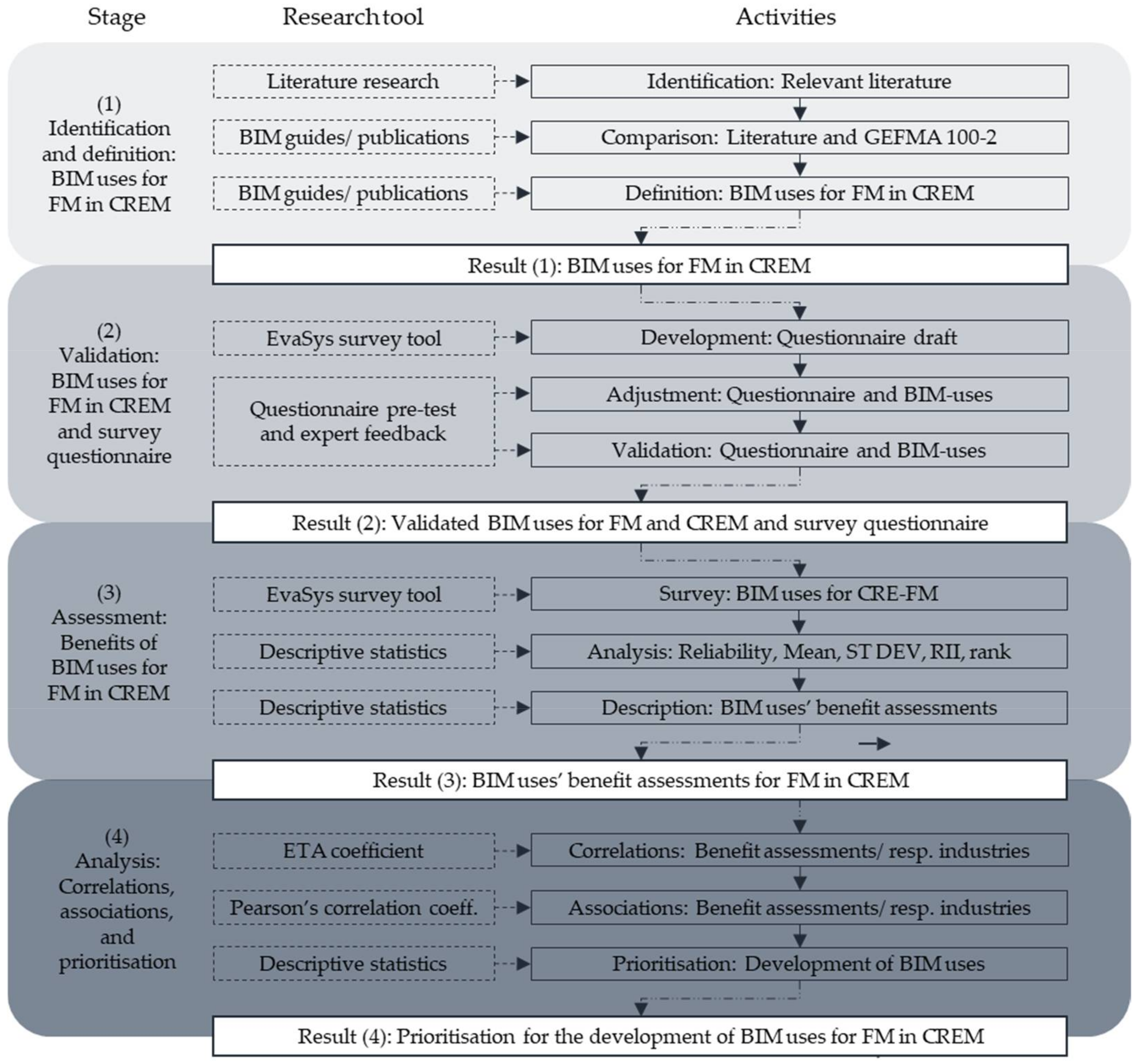
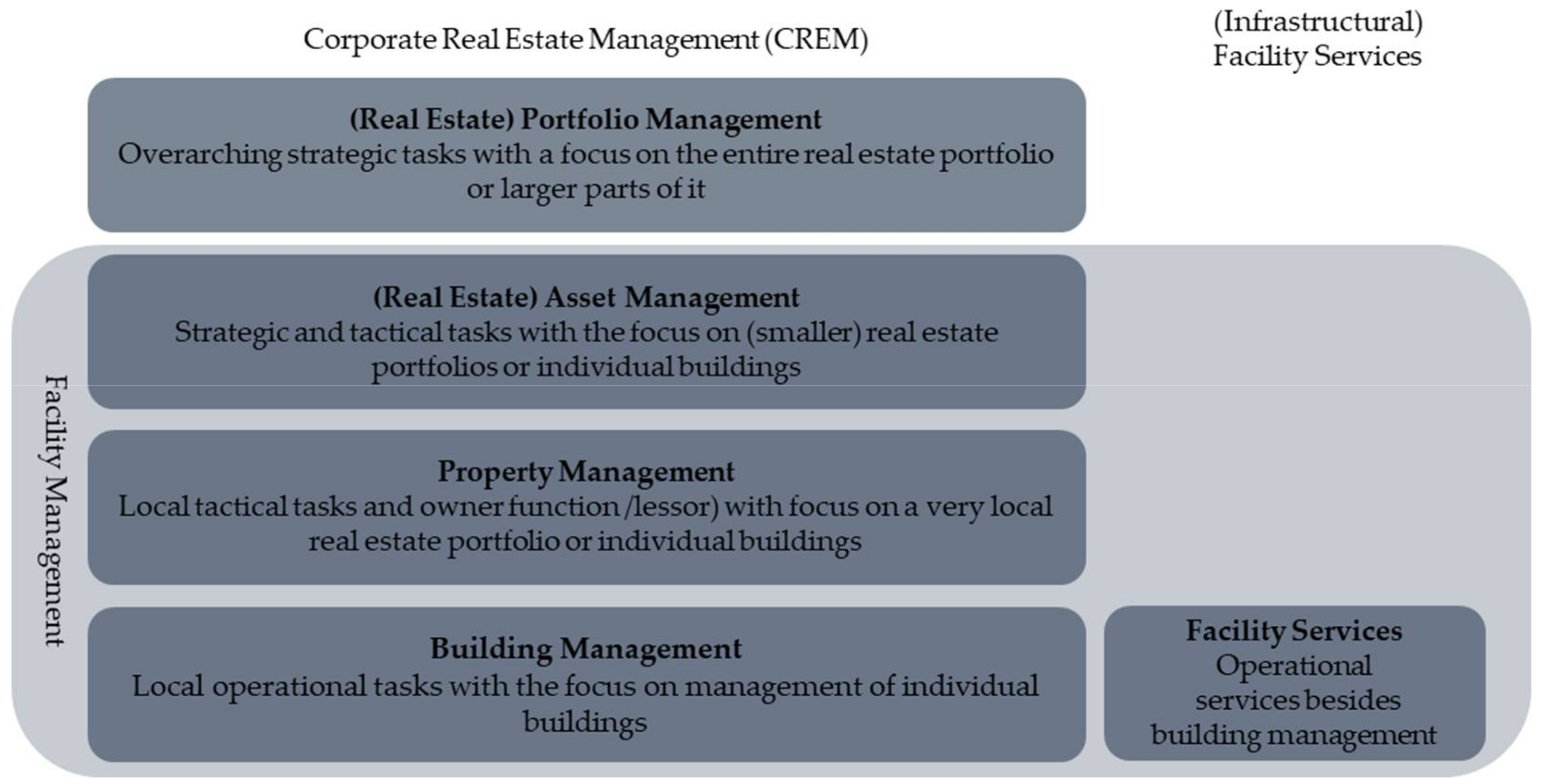
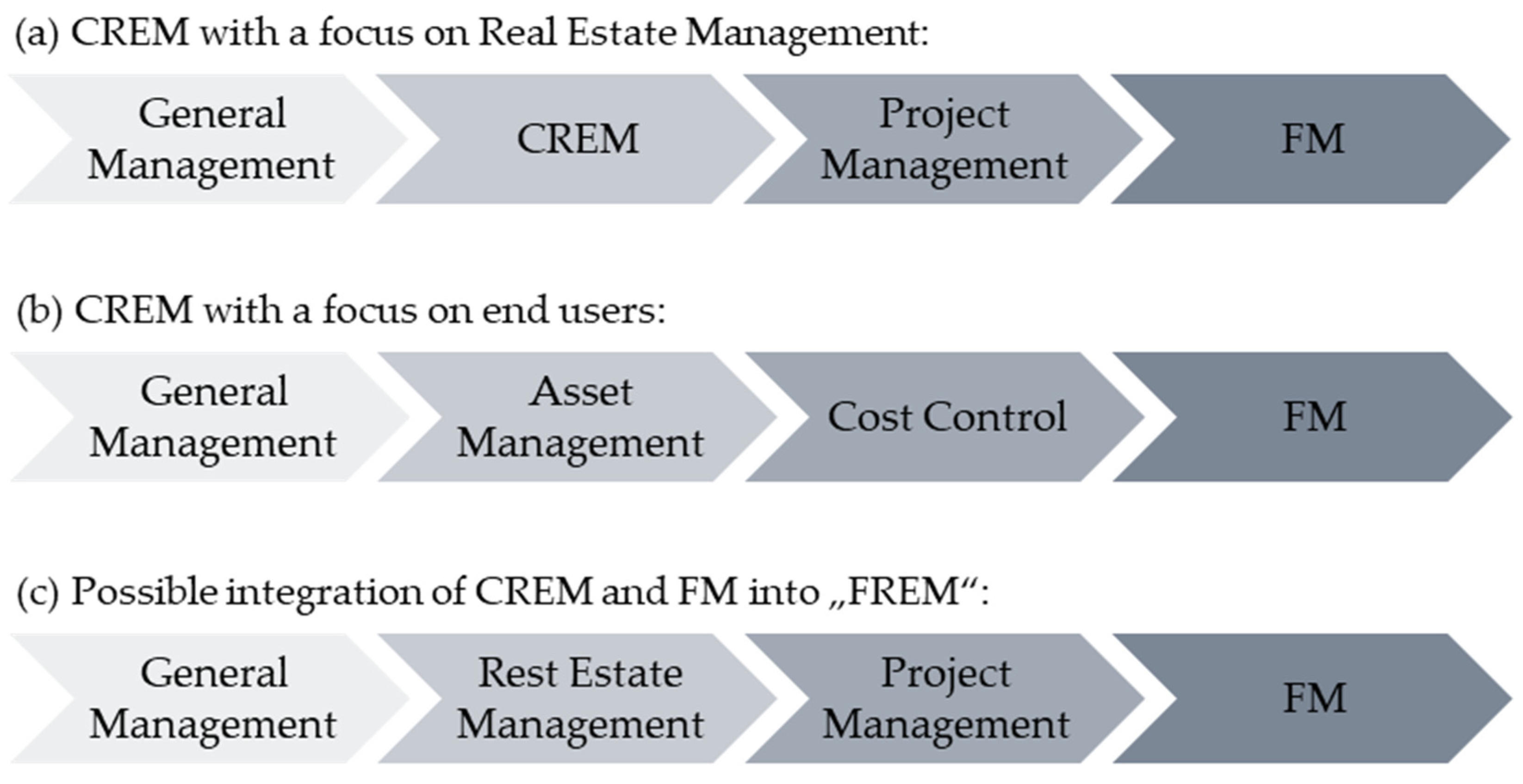

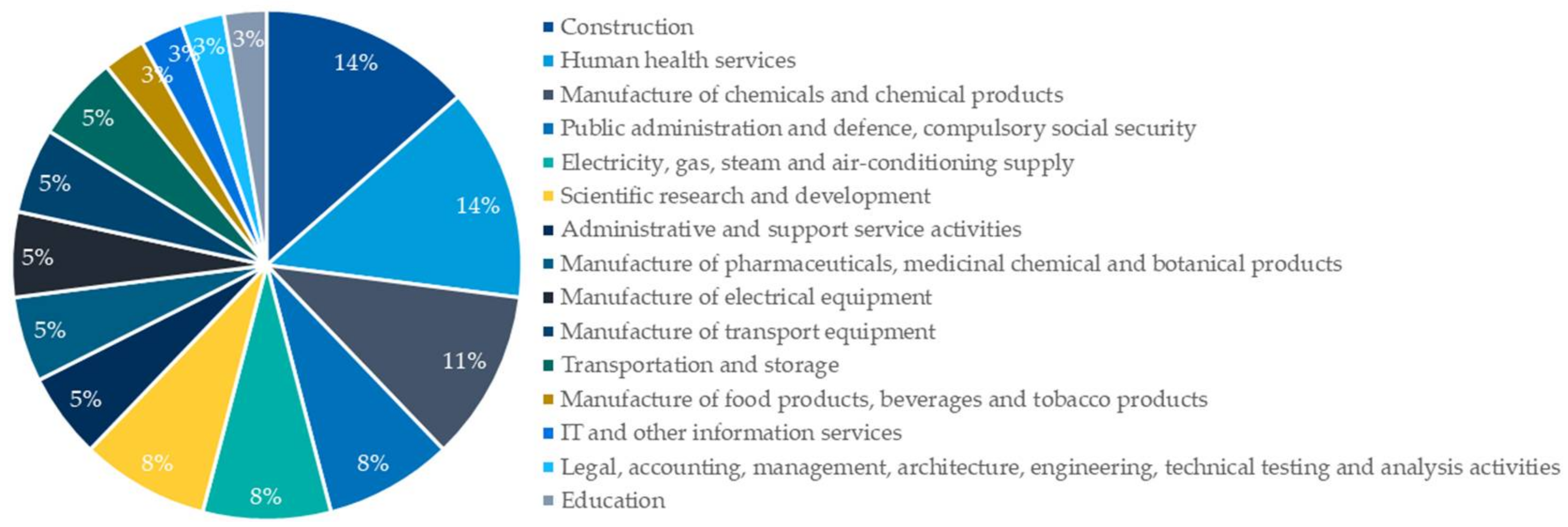
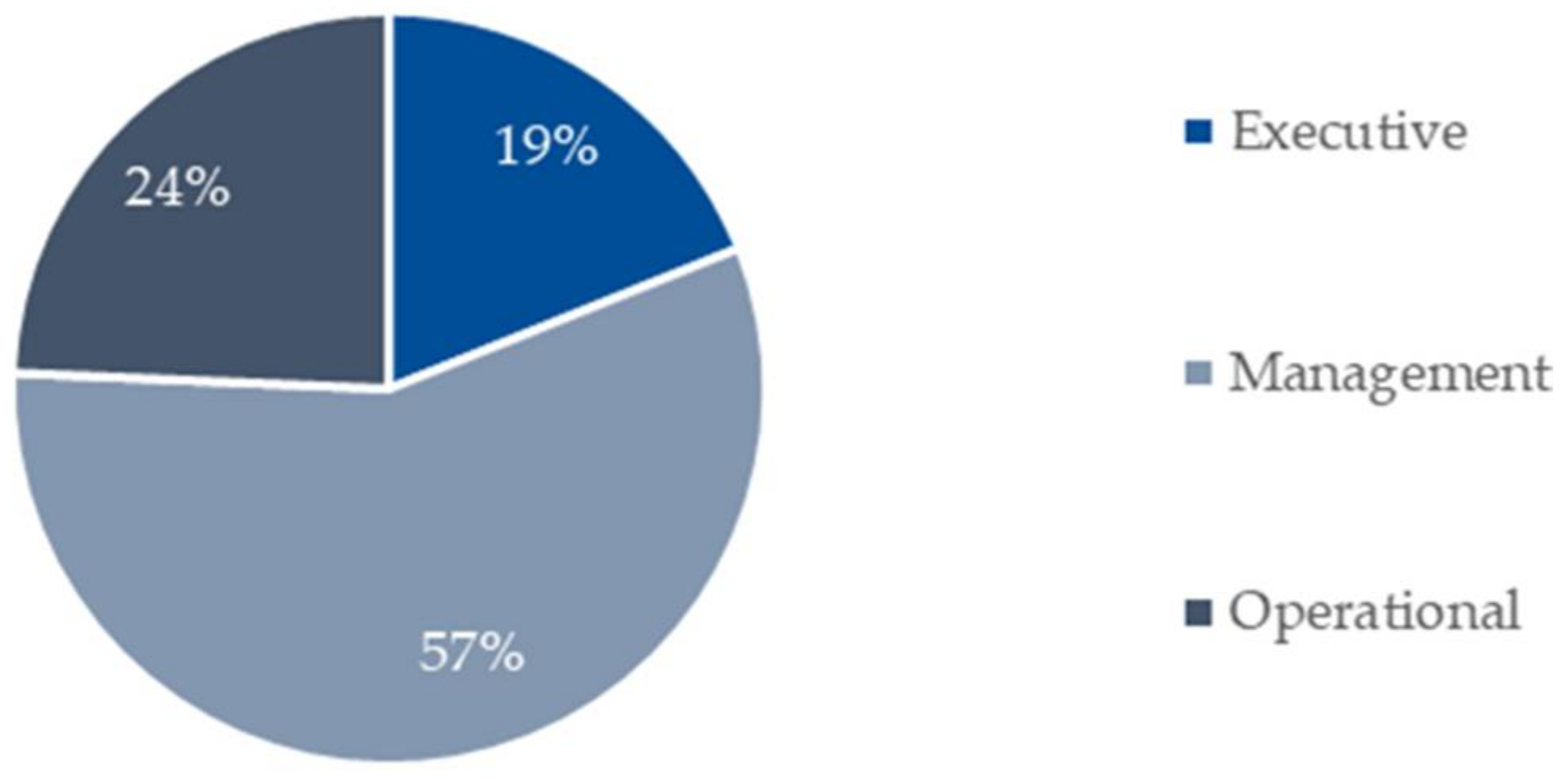

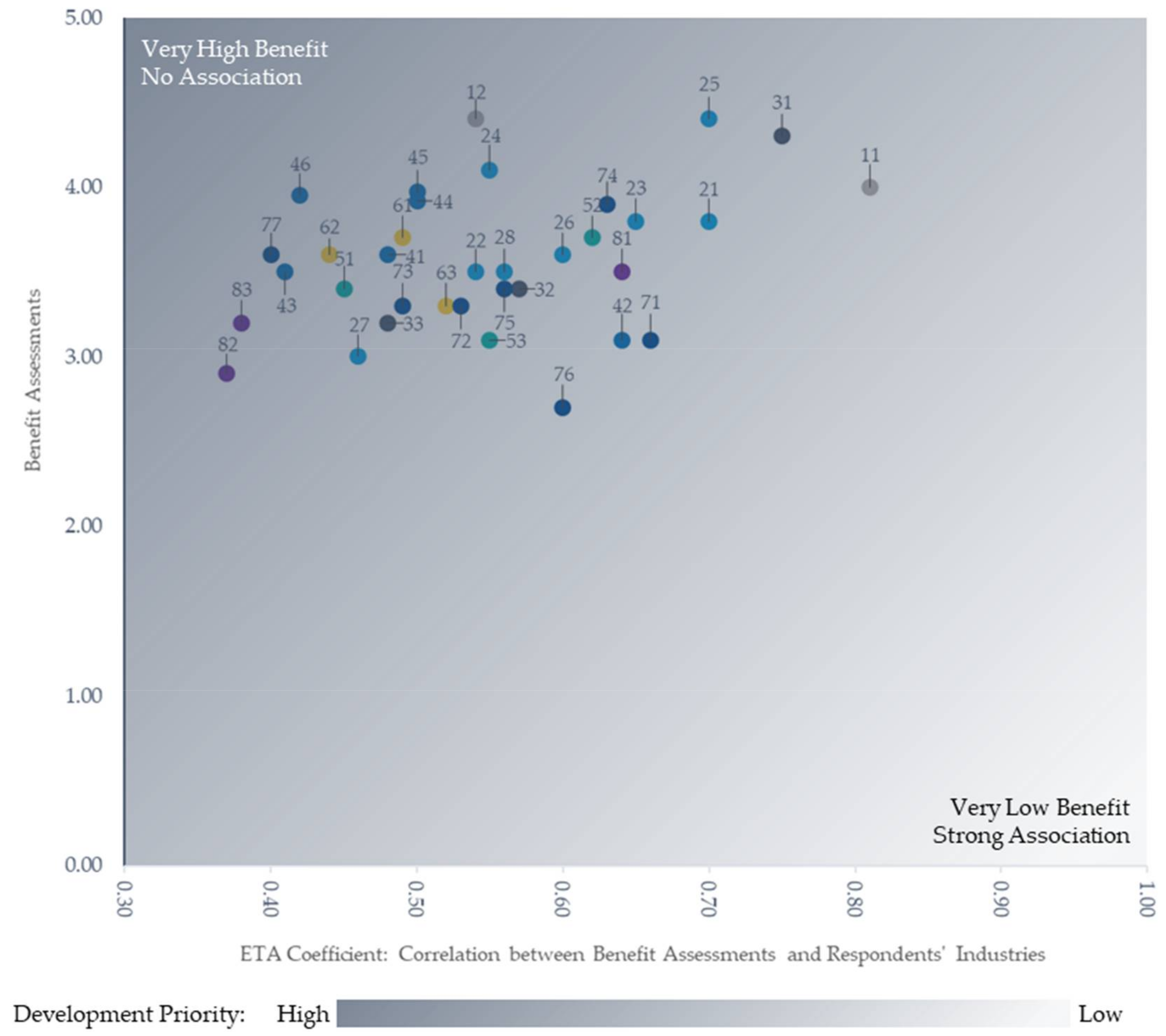
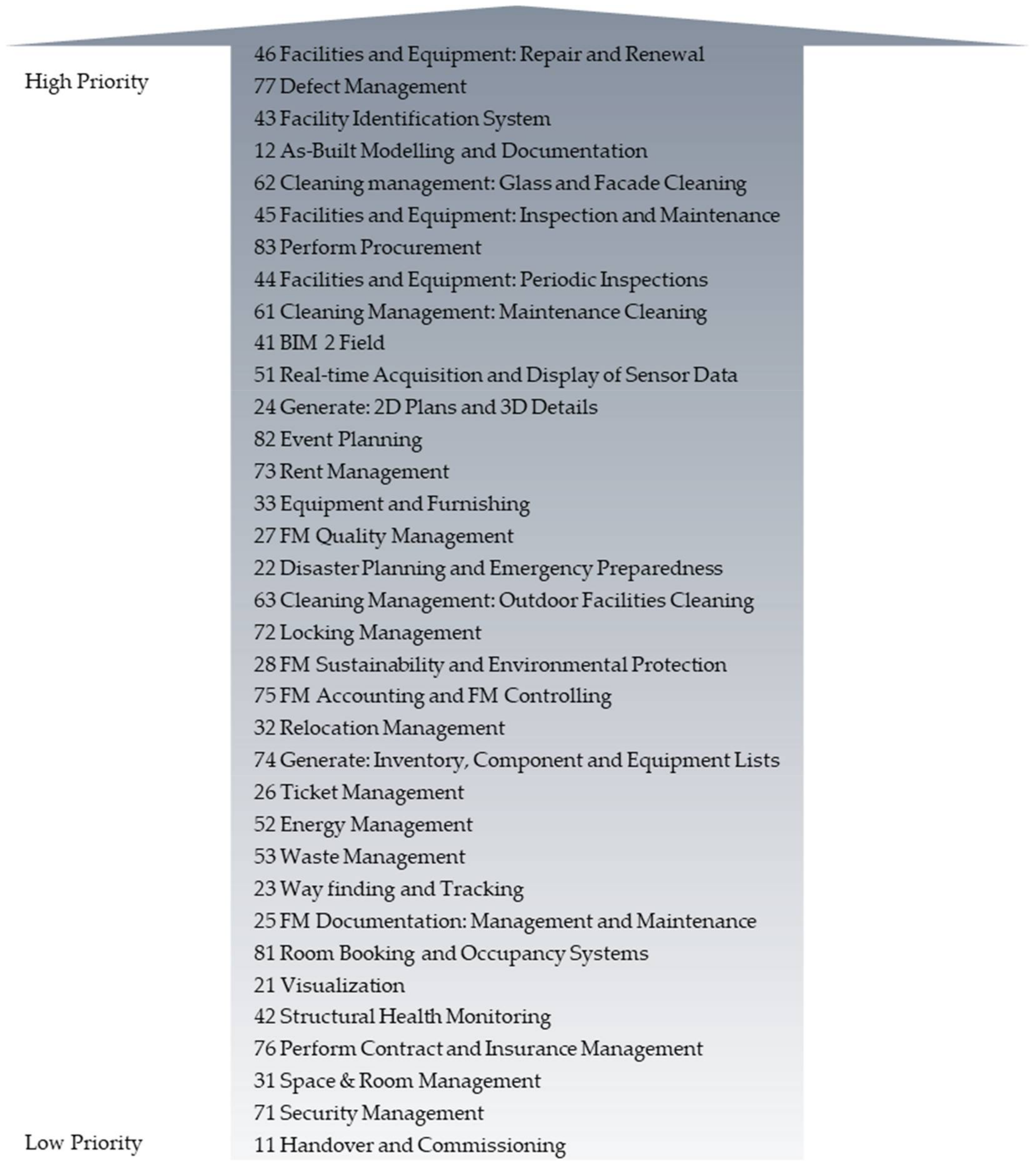
| Authors | Year | Approach |
|---|---|---|
| Becerik-Gerber et al. [18] | 2012 | Potential FM application areas that BIM can be used for, mainly within the context of PRE |
| McArthur and Sun [19] | 2015 | Analysis and prioritisation of BIM uses in public-private partnerships in different industries |
| Mayo and Issa [55] | 2016 | Examination of BIM use information requirements based on categories within the context of PRE |
| Cavka et al. [16] | 2017 | Definition of owner information requirements based on O&M functions within the context of PRE |
| Miettinen et al. [52] | 2018 | Analysis of the current state of implementation of BIM for FM within the context of PRE |
| Alshorafa and Ergen [14] | 2020 | Definition of specific IR and their LOD, depending on BIM uses for FM identified during an expert survey |
| Authors | Year | Approach |
|---|---|---|
| Lazar and McArthur [56] | 2016 | Case study demonstration of BIM data visualisation benefits within the context of CRE |
| Carbonari et al. [25] | 2018 | Analysis of possible BIM application areas for operations within the context of CRE |
| FM Main Process | No. | BIM Use |
|---|---|---|
| 1 Commissioning | 11 | Handover and Commissioning |
| 12 | As-Built Modelling and Documentation | |
| 2 Manage Operations | 21 | Visualisation |
| 22 | Disaster Planning and Emergency Preparedness | |
| 23 | Wayfinding and Tracking | |
| 24 | Generate: 2D Plans and 3D Details | |
| 25 | FM Documentation: Management and Maintenance | |
| 26 | Ticket Management | |
| 27 | FM Quality Management | |
| 28 | FM Sustainability and Environmental Protection | |
| 3 Provide Workplaces | 31 | Space and Room Management |
| 32 | Relocation Management | |
| 33 | Equipment and Furnishing | |
| 4 Operations | 41 | BIM 2 Field |
| 42 | Structural Health Monitoring | |
| 43 | Facility Identification System | |
| 44 | Facilities and Equipment: Periodic Inspections | |
| 45 | Facilities and Equipment: Inspection and Maintenance | |
| 46 | Facilities and Equipment: Repair and Renewal | |
| 5 Supply and Disposal | 51 | Real-time Acquisition and Display of Sensor Data |
| 52 | Energy Management | |
| 53 | Waste Management | |
| 6 Cleaning and Maintaining | 61 | Cleaning Management: Maintenance Cleaning |
| 62 | Cleaning management: Glass and Facade Cleaning | |
| 63 | Cleaning Management: Outdoor Facilities Cleaning | |
| 7 Asset Management | 71 | Security Management |
| 72 | Locking Management | |
| 73 | Rent Management | |
| 74 | Generate: Inventory, Component, and Equipment Lists | |
| 75 | FM Accounting and FM Controlling | |
| 76 | Perform Contract and Insurance Management | |
| 77 | Defect Management | |
| 8 Provide Support | 81 | Room Booking and Occupancy Systems |
| 82 | Event Planning | |
| 83 | Perform Procurement |
| Pearson’s Correlation Coefficient | Interpretation |
|---|---|
| 0.00 | No association between the two variables |
| 0.01–0.19 | No or negligible association between the variables |
| 0.2–0.39 | A weak association between the variables |
| 0.4–0.69 | Medium association between the variables |
| 0.70–1.0 | Strong association between the variables |
Publisher’s Note: MDPI stays neutral with regard to jurisdictional claims in published maps and institutional affiliations. |
© 2022 by the authors. Licensee MDPI, Basel, Switzerland. This article is an open access article distributed under the terms and conditions of the Creative Commons Attribution (CC BY) license (https://creativecommons.org/licenses/by/4.0/).
Share and Cite
Benn, M.; Stoy, C. BIM for CREM: Exploring the Benefit of Building Information Modelling for Facility Management in Corporate Real Estate Management. Buildings 2022, 12, 400. https://doi.org/10.3390/buildings12040400
Benn M, Stoy C. BIM for CREM: Exploring the Benefit of Building Information Modelling for Facility Management in Corporate Real Estate Management. Buildings. 2022; 12(4):400. https://doi.org/10.3390/buildings12040400
Chicago/Turabian StyleBenn, Maximilian, and Christian Stoy. 2022. "BIM for CREM: Exploring the Benefit of Building Information Modelling for Facility Management in Corporate Real Estate Management" Buildings 12, no. 4: 400. https://doi.org/10.3390/buildings12040400
APA StyleBenn, M., & Stoy, C. (2022). BIM for CREM: Exploring the Benefit of Building Information Modelling for Facility Management in Corporate Real Estate Management. Buildings, 12(4), 400. https://doi.org/10.3390/buildings12040400






